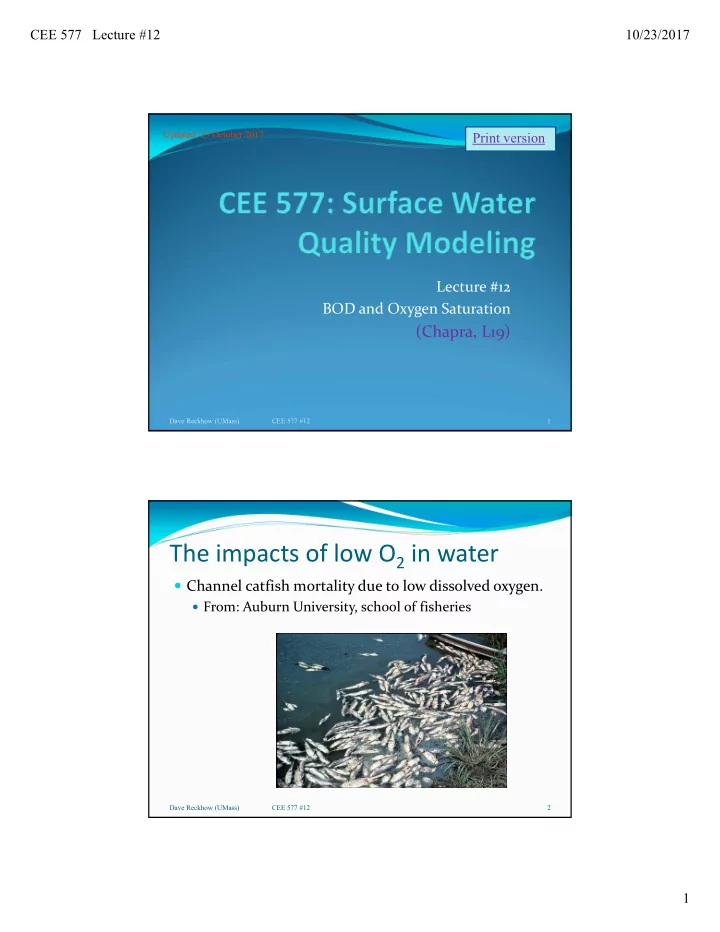

CEE 577 Lecture #12 10/23/2017 Updated: 23 October 2017 Print version Lecture #12 BOD and Oxygen Saturation (Chapra, L19) Dave Reckhow (UMass) CEE 577 #12 1 The impacts of low O 2 in water Channel catfish mortality due to low dissolved oxygen. From: Auburn University, school of fisheries Dave Reckhow (UMass) CEE 577 #12 2 1
CEE 577 Lecture #12 10/23/2017 Dissolved Oxygen (D.O.) Oxygen is a rather insoluble gas, and as a result its is often the limiting constituent in the purification of wastes and natural waters. Its solubility ranges from 14.6 mg/l at 0 o C to about 7 mg/l at 35 o C. In addition to temperature, its solubility varies with barometric pressure and salinity. The saturation concentration of oxygen in distilled water may be calculated from the following empirical expression: Dave Reckhow (UMass) CEE 577 #12 3 DO saturation formula P wv P 1 1 P C C P s sl 1 1 P wv where: P vw = water vapor partial pressure (atm) = 11.8571 - (3840.70/T k ) + (216,961/T k 2 ) P = total atmospheric (barometric) pressure (atm), which may be read directly or calculated from a remote reading at the same time from: = P o - (0.02667) H/760 H = Difference in elevation from the location of interest (at P) to the reference location (at P o ) in feet. Dave Reckhow (UMass) CEE 577 #12 4 2
CEE 577 Lecture #12 10/23/2017 DO (cont.) P o = Simultaneous barometric pressure at a nearby reference location = pressure/temperature interactive term = 0.000975 - (1.426x10 -5 T) + (6.436x10 -8 T 2 ) T = Temperature in degrees centigrade C s1 = Saturation concentration of oxygen in distilled water at 1 atmosphere total pressure. ln(C s1 ) = -139.34411 + (1.575701x10 5 /T k ) - (6.642308x10 7 /T k 2 ) + (1.243800x10 10 /T k 3 ) - (8.621949x10 11 /T k 4 ). T k = Temperature in degrees Kelvin (T k = T + 273.15) Dave Reckhow (UMass) CEE 577 #12 5 DO temperature profile http://www.fondriest.com/environmental- measurements/parameters/water- quality/dissolved-oxygen/ Dave Reckhow (UMass) CEE 577 #12 6 3
CEE 577 Lecture #12 10/23/2017 DO Temperature Profile Dave Reckhow (UMass) CEE 577 #12 7 Oxygen and aquatic systems http://www.fondriest.com/environmental- measurements/parameters/water- quality/dissolved-oxygen/ Dave Reckhow (UMass) CEE 577 #12 8 4
CEE 577 Lecture #12 10/23/2017 DO (cont.) Minimum concentration is required for the survival of higher aquatic life larval stages of certain cold-water fishes are quite sensitive Significant discharges of organic wastes may depress the D.O. concentrations in receiving waters microbially-mediated oxidation each state has established ambient dissolved oxygen standards Another use of D.O. is the assessment of oxidation state in groundwaters and sediments Dave Reckhow (UMass) CEE 577 #12 9 DO (cont.) also a very important parameter in biological treatment processes indicate when aerobic and anaerobic organisms will predominate used to assess the adequacy of oxygen transfer systems indicate the suitability for the growth of such sensitive organisms such as the nitrifying bacteria. used in the assessment of the strength of a wastewater through either the Biochemical Oxygen Demand (BOD) or respirometric studies. Dave Reckhow (UMass) CEE 577 #12 10 5
CEE 577 Lecture #12 10/23/2017 Dissolved Oxygen Solutions reduction of BOD by biological WW treatment nutrient control Ambient Water Quality Criteria established by EPA in "Gold Book" dependent on type of fish, averaging period Ambient Water Quality Standards [enforceable] established by states, and other local agencies dependent on use classification Dave Reckhow (UMass) CEE 577 #12 11 Oxygen Demand It is a measure of the amount of “reduced” organic and inorganic matter in a water Relates to oxygen consumption in a river or lake as a result of a pollution discharge Measured in several ways BOD ‐ Biochemical Oxygen Demand COD ‐ Chemical Oxygen Demand ThOD ‐ Theoretical Oxygen Demand Dave Reckhow (UMass) CEE 577 #12 12 6
CEE 577 Lecture #12 10/23/2017 BOD: A Bioassay Briefly, the BOD test employs a bacterial seed to catalyze the oxidation of 300 mL of full-strength or diluted wastewater. The strength of the un-diluted wastewater is then determined from the dilution factor and the difference between the initial D.O. and the final D.O. BOD Bottle BOD DO DO t i f Dave Reckhow (UMass) CEE 577 #12 13 Chapra’s Glucose example C 6 H 12 O 6 + 6O 2 = 6CO 2 + 6H 2 O 12 10 Oxygen (mg/L) 8 L t D.O. Glucose 6 Oxygen 4 2 0 0 5 10 15 20 25 Time (days) Dave Reckhow (UMass) CEE 577 #12 14 7
CEE 577 Lecture #12 10/23/2017 BOD with dilution When BOD>8mg/L BOD = DO - DO i f t V s V b Where BOD t = biochemical oxygen demand at t days, [mg/L] = initial dissolved oxygen in the sample bottle, DO i [mg/L] = final dissolved oxygen in the sample bottle, [mg/L] DO f = sample bottle volume, usually 300 or 250 mL, [mL] V b = sample volume, [mL] V s Dave Reckhow (UMass) CEE 577 #12 15 BOD ‐ loss of biodegradable organic matter L o (oxygen demand) L or BOD remaining L o -L t = BOD t L t Time BOD BOD BOD BOD BOD Bottle Bottle Bottle Bottle Bottle Dave Reckhow (UMass) CEE 577 #12 16 8
CEE 577 Lecture #12 10/23/2017 The BOD bottle curve L=oxidizable carbonaceous material remaining to be oxidized 35 30 BOD or Y (mg/L) 25 NBOD L o 20 L t 15 CBOD 10 5 0 0 2 4 6 8 Time (days) BOD y L L t t o t Dave Reckhow (UMass) CEE 577 #12 17 To next lecture Dave Reckhow (UMass) CEE 577 #12 18 9
Recommend
More recommend